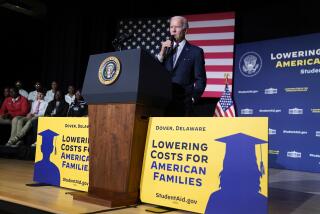Grant Cuts Forcing College Students Into Debt
Faced with ever-rising tuition costs and a dramatic drop in government scholarships under the Reagan Administration, so many college students are being forced to borrow so much money that government officials and educators now fear that the students are turning into what one official called “the debtor generation.”
A study released today by UCLA and the American Council on Education shows that freshman participation in Pell Grants, the government’s major student-grant program, has declined by nearly half since 1980. According to the study, only 16.9% of the freshmen entering college in fall of 1986 reported receiving Pell Grants, down from 31.5% six years earlier.
President Reagan, meanwhile, is calling for even more cuts in student grants. In his fiscal 1988 budget proposals released last week, the President asked Congress to slash Pell Grants by an additional one-third in the coming year.
As federal grants have diminished, student indebtedness has risen dramatically. A report released this month by a joint House and Senate committee found student borrowing is now five times what it was a decade ago, with the result that one-third to one-half of all students are now leaving college in debt.
Dependency on Loans
Part of the reason for the dramatic increase in dependency on loans, according to officials in the Reagan Administration, is that college costs have risen so substantially, outstripping inflation in each of the last six years. According to reports from the U.S. Department of Education, tuition--excluding room, board, books and other expenses--now averages $1,337 a year at public universities and $5,793 at private four-year colleges.
Students who receive loans to attend two-year colleges are graduating with debts averaging $3,303, a recent study of college student-aid offices found. For those at public universities, the average indebtedness is $6,685, and at private universities the average is $8,950.
“Who’s to blame? The colleges for raising tuition? The government for cutting grants?” one official in the U.S. Department of Education asked rhetorically. Refusing to be quoted by name, like many officials in the department, he added: “There’s a lot of arguing around here. But the point is we are creating a generation of debtors--the debtor generation--and that’s something no one likes to think about or talk about.”
It is, however, something that should be discussed, the report of the Congressional Joint Economic Committee said. “Growing student indebtedness has raised questions about the implications of the debt burdens for the national economy, for the economic well-being of borrowers, for equality of access to higher education and even for the educational process itself,” the report said.
The decline in federal support for college scholarships combined with the sharp rise in college costs seems to be having a particular impact on many low- and middle-income American families, said UCLA professor Alexander W. Astin, director of the UCLA-American Council study.
Recent research, Astin said, indicates that some students, faced with the prospect of large education debts as the only way to finance their education, may avoid going to college in the first place, while others are more likely to drop out before getting their degrees.
Perhaps the most troubling, though hardly surprising, aspect of the government’s unwillingness to maintain support for student grants is that those students who now attend college seem to be coming from increasingly well-to-do families, said Kenneth C. Green, associate director of the study.
‘Shifts in Family Income’
In the 1986 national survey of college freshmen conducted annually by UCLA, only 36.6% of the surveyed students said they came from families with incomes under $30,000 a year, compared to 68.1% in 1980, the peak of President Carter’s Middle Income Student Assistance Act, which provided substantial college assistance to families in the middle-income ranges.
“These shifts in family income are too sharp to be attributed solely to the impact of inflation,” Green said. “Recent changes in federal aid eligibility seem to have affected the college-going decisions of large numbers of students from low- and midddle-income families.”
Today, students whose families make more than $28,000 cannot get government grants, and President Reagan proposes to lower the ceiling to $20,000 next year. If the 1980 standards still applied, according to Green, families with incomes of up to $41,000 would be eligible.
Although some educators have speculated recently that students’ growing reliance on loans would have an impact on their choice of majors and eventual careers, there is little more than anecdotal evidence to support these fears. The UCLA study, which now surveys nearly 300,000 students at more than 370 schools annually, found no clear patterns to indicate that this is so, Green said.
Business, according to the study, continues to be the most popular career among college freshmen, rising to an all-time high of 24.1% this year, up from 23.9% in 1985 and more than double the 1955 figure of 11.6%.
Business Careers Popular
“The continuing popularity of business careers is consistent with changes in student values we have been observing over the same period,” Astin said. Student endorsement of “being very well-off financially” as a “very important” or “essential” goal in life continued its steady climb to an all-time high of 73.2% this year--compared to 70.9% last year and 39.1% in 1970.
On the other hand, the study found, interest in teaching has also risen substantially, from 4.7% of the freshmen surveyed in 1982 to 7.3% this year, while students’ interest in computer science has dropped from 8.8% in 1982 to 3.5%. Interest in engineering has also declined from 12% in 1982 to 9.7%, as has the proportion of students planning to pursue medical careers, which fell from its peak of 7.4% in 1973 to 5.6% this year.
“It’s difficult to say what all these shifts mean,” Green said. “The one thing that is clear is that, whatever field they may move toward, students are interested, if not in wealth, at least financial security--perhaps to an extent we have not seen since the Great Depression.
“The reason this is so is probably quite obvious,” Green concluded. “A substantial number of students have very large debts to think about paying back, which has got to have some impact on what they expect to do with their lives.”
More to Read
Sign up for Essential California
The most important California stories and recommendations in your inbox every morning.
You may occasionally receive promotional content from the Los Angeles Times.










